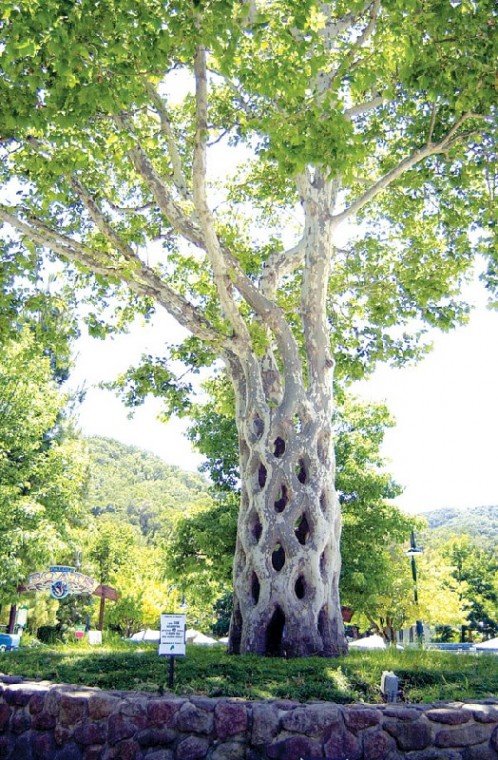Some kids hate their freckles. Others wish they had blonde hair
instead of brown. Likewise, some farmers would rather grow more
Bing cherry trees than Rainier, or more trees producing Blenheim
apricots than the Patterson variety.
To achieve a specific variety of fruit, many local farmers use a
technique called grafting
– shorthand for joining parts of trees together in such a way
that they unite and grow as one tree.
Some kids hate their freckles. Others wish they had blonde hair instead of brown. Likewise, some farmers would rather grow more Bing cherry trees than Rainier, or more trees producing Blenheim apricots than the Patterson variety.
To achieve a specific variety of fruit, many local farmers use a technique called grafting – shorthand for joining parts of trees together in such a way that they unite and grow as one tree. On a smaller scale, grafting also can be done in your own backyard.
One reason farmers choose to graft is to guarantee they’ll get a specific variety of fruit. The seed from a Fuji apple, for example, will produce an apple tree.
But most trees that are cross-pollinated produce a seed that combines traits from both parents, so chances are it won’t be a Fuji apple tree.
But by taking a stem of a Fuji apple tree that has buds on it and joining it with part of an apple tree of a different variety that’s already growing, farmers essentially can create their own Fuji apple trees. The variety is a clone of the parent plant.
Additionally, grafting allows farmers to grow multiple varieties of fruits on one tree, allowing them to produce more varieties in less space.
Most fruit trees require pollinators, but grafting a branch of another variety onto an existing tree eliminates the need to plant another tree to act as a pollinator.
Also, if farmers plant one variety and later decide they want a different variety, grafting allows them to change the variety without starting from scratch with a new seed.
Besides introducing a wider selection of varieties, grafting also can be used to preserve older varieties of fruits, control the size of trees and repair damaged trees.
George Rajkovich, who grows apricots and cherries at Hollister’s Fairhaven Orchards, has been grafting trees for about 30 years. He estimated he grafted about 150 trees last year.
“Grafting is mainly used to change the variety of a tree,” he said. “If we need a pollinator variety, we can graft it to whatever we want. Once you know how to graft, it’s very easy to do, no matter what variety it is.”
Tree grafting isn’t a technique exclusive to fruit farmers. In the case of Gilroy’s Bonfante Gardens, grafting also can be used to preserve older trees and create unusual horticultural wonders.
The gardens’ well-known circus trees, the original creations of Swedish immigrant Axel Erlandson, once grew at the Tree Circus in Scotts Valley.
Erlandson grafted about 70 spiral-shaped sycamore, box elder, ash and Spanish cork trees, 25 of which were moved to Gilroy in 1985.
Nineteen of the trees are available for public viewing at Bonfante Gardens and showcase the aesthetic wonders of grafting.
The basket tree, for instance, is six sycamores melded together in more than 40 combinations to create a basket shape.
Grafting, however, isn’t reserved for farmers and large-scale horticulturists, said Jose Luis Calderon, Bonfante Gardens’ landscape supervisor.
“It’s pretty easy, and you can do it at home,” he said. “It works well with maple, small sycamore and ficus trees. I’ve also seen people graft apple trees in their backyards. You can grow one tree with three different kinds of fruit – red, yellow and green apples, all in the same tree. That way, you don’t have to go to the market twice.”
Learning how to graft requires a basic understanding of three terms: rootstock, scion and cambium. The rootstock is the part of the tree that is already growing, and that’s where the graft is placed. The scion is the piece of wood that is the variety you want to grow, and is attached to the rootstock. Cambium is the layer of cells between the outer bark and the wood part of the plant where growth occurs. For successful grafting, the cambium of the rootstock must be united with cambium of the scion.
The best time to graft is in early spring. A good pruning saw, a pair of pruners and – most importantly – a very sharp knife are among the tools needed.
There are several different techniques to grafting, the most common being a splice graft, Calderon said.
In a splice graft, the grafter makes a 1 1/2- to 2-inch cut at a 45-degree angle on both the scion and the rootstock, then ties the two pieces to each other.
One thing to keep in mind while grafting at home is that the varieties have to be genetically related, said Andy Mariani, owner of Andy’s Orchard, a 30-acre farm in Morgan Hill, who has taught classes on grafting.
“Some people think if you graft an apricot with a plum, you’ll get a plumcot,” he said. “But it doesn’t work that way.”
Mariani grows a variety of heirloom fruits including black tartarian cherries, gold dust peaches and elephant heart plums. A handful of the less common varieties he grows – some about 2,000 years old – are rapidly being replaced by mass-produced fruit that doesn’t have the same texture and flavor, Mariani said.
“That’s one of the things we try to do – preserve the heirlooms,” he said. “It’s like a museum. … (Grafting) is kind of a mystery. It’s kind of a miracle when you’re putting two different kinds of wood together and they grow.”













